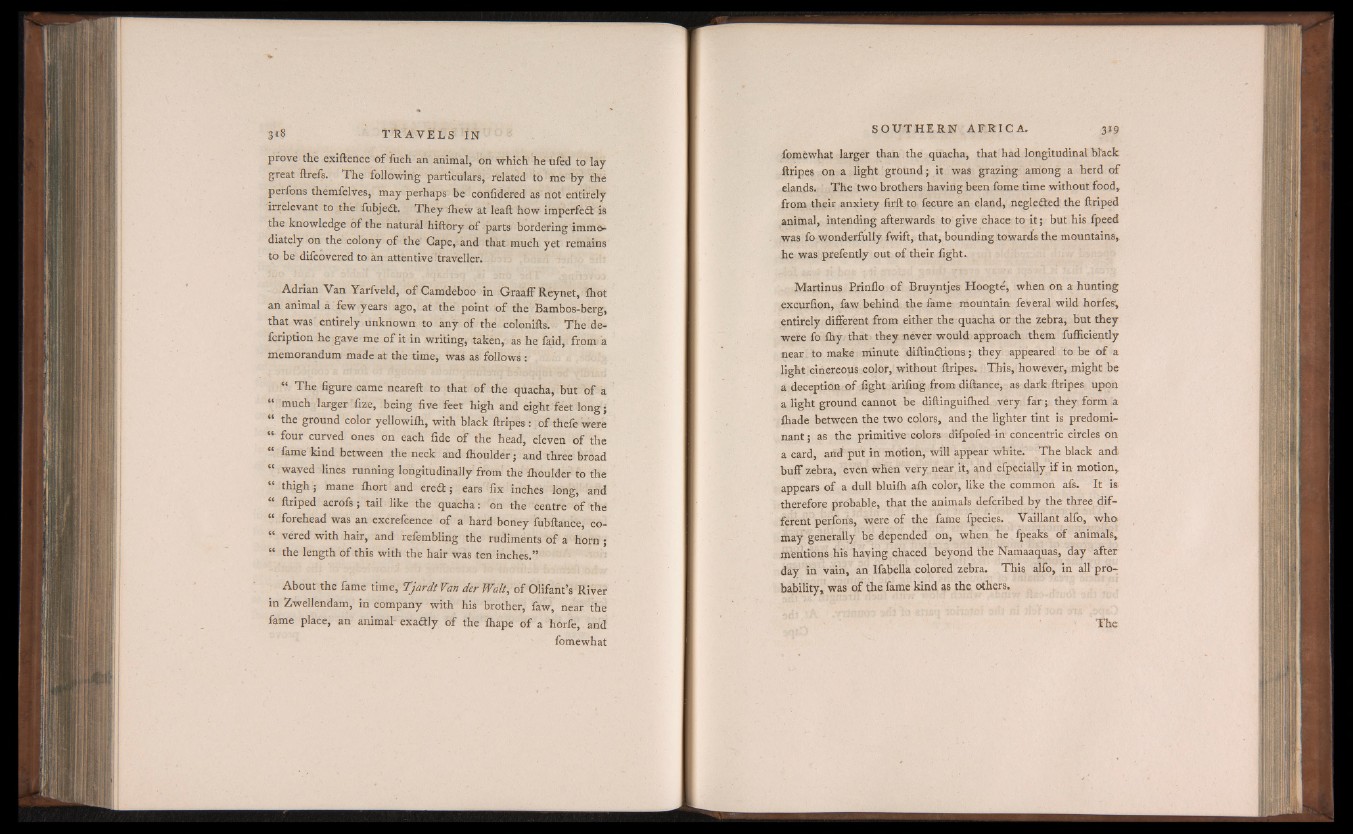
prove the exiftence o f fuch an animal, on which he ufed to lay
great ftrefs. The following particulars, related to me by the
perfons themfelves, may perhaps be confidered as not entirely
irrelevant to the fubje£t. They ihew at leaft how imperfe£t is
the knowledge of the natural hiftory of parts bordering imme-
diately on the colony of the Cape, and that much yet remains
to be difcovered to an attentive traveller.
Adrian Van YarlVeld, o f Camdeboo in Graaff Reynet, ihot
an animal a few years ago, at the point of the Bambos-berg,
that was entirely unknown- to any of the colonifts. The de-
fcription he gave me of it in writing, taken, as he faid, from a
memorandum made at the time, was as follows :
“ The figure came neareft to that of the quacha, but of a
much larger fize, being five feet high and eight feet long;
“ the ground color yellowilh, with black ftripes : of thefe were
“ four curved ones on each fide o f the head, eleven of the
“ fame kind between the neck and ihoulder; and three broad
“ waved lines running longitudinally from the ihoulder to the
| thigh ; mane fliort and ere<3 ; ears fix inches long, and
“ ftriped acrofs; tail like the quacha: on the centre o f the
“ forehead was an excrefcence o f a hard boney fubftance, co-
“ vered with hair, and refembling the rudiments o f a horn ;
“ the length of this with the hair was ten inches.”
About the fame time, Tjardi Van der Walt, ofOlifant’s River
in Zwellendam, in company with his brother, faw, near the
fame place, an animal exadly of the ihape of a horfe, and
fomewhat
fomewhat larger than the quacha, that had longitudinal black
ftripes on a light ground; it was grazing among a herd o f
elands. The two brothers having been fome time without food,,
from their anxiety firft to fecure an eland, negle£ted the ftriped
animal, intending afterwards to give chace to i t ; but his fpeed
was fo wonderfully fwift, that, bounding towards the mountains,
he was prefently out of their fight.
Martinus Prinflo of Bruyntjes Hoogte, when on a hunting
excurfion, faw behind the fame mountain feveral wild horfes,
entirely different from either the quacha or the zebra, but they
were fo ihy. that they never would approach them fufficiently
near to make minute diftindtions; they appeared to be of a
light cinereous color, without ftripes. This, however, might be
a deception of fight arifing from diftanee, as dark ftripes upon
a light ground cannot be diftinguiihed very far; they form a
ihade between the two colors, and the lighter tint is predominant
; as the primitive colors difpofed in- concentric circles on
a card, and put in motion, will appear white. The black and
buff zebra, even when very near it, and efpecially if in motion,
appears of a dull bluiih aih color, like the common afs. It is
therefore probable, that the animals defcribed by the three different
perfons, were of the iame fpecies. Vaillant alfo, who
may generally be depended on, when he fpeaks of animals,
mentions his haying chaced beyond the Namaaquas, day after
day in vain, an Ifabella colored zebra. This alfo, in all probability,
was of the fame kind as the others.